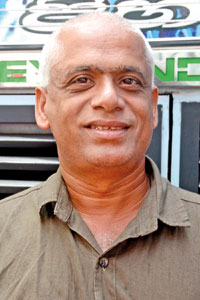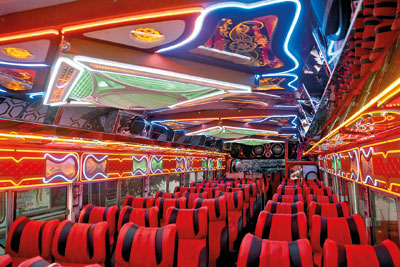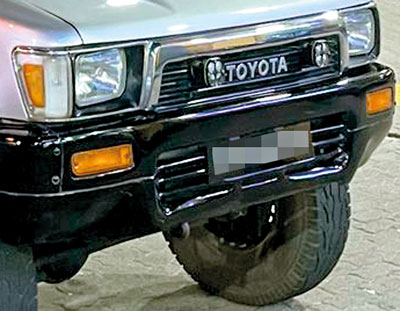News
Vehicle owners in a spin over Clean Sri Lanka regulations
View(s):- Questions over registered modifications, unauthorised modifications and lack of information
- Govt. says the project aims at major overhaul of transport system
By Tharushi Weerasinghe
Vehicle owners are claiming that the implementation of regulations for vehicles under the Clean Sri Lanka project are confusing and arbitrary following the introduction of a registration process for some modifications.
“I feel like the regulation just depends on whatever the examiner is feeling that day so you just go in hoping they’re in a good mood,” said 4 x 4 enthusiast Yanik Perera from Wattala. He noted that most of the communication and information surrounding the new regulations came from WhatsApp groups he was in with other car enthusiasts in the country. He added that while he has been stopped by police on a number of occasions for inspections of his truck, to which he has attached fog lights, he has not received any citations yet.

Businessman W.D. Ishanka
“I don’t understand the logic behind this project, a man that gets into an accident with the vehicle dies whether I have a nice speaker inside or not, it isn’t like the registration gives it some new safety measure,” said W.D. Ishanka a bus owner and driver from Kalutara. “We were told that we can keep some modifications if we register and pay a certain amount,” he said. He estimates that registering the modifications on his bus will cost about Rs. 300,000. He added that he had not removed any of his modifications as he is hoping to use the grace period provided to make the repairs after registering the modifications he will be allowed to keep.
“Only modifications that do not pose an immediate threat to drivers, passengers, or pedestrians will be given the grace period of three months which ends on March 12,” said Police Media Spokesperson SSP K. B. Manathunga. Modifications, such as window coverings from the inside, pose an immediate danger to drivers or passengers and must be removed immediately. According to SSP Manathunga, items that do not pose immediate harm—such as statues, hanging decorations, or lights on the sides of vehicles—are allowed a grace period. “These aesthetic modifications must be addressed within three months,” he said. He added that the police are prioritising safety and taking steps to ensure that modifications do not compromise the well-being of those on the road.
“I carry a copy of the gazette around with me to show cops who pull me over and try to fine me for modifications that are permitted” said Priyantha Perera from Polonnaruwa. He makes his living by driving a tuk-tuk around Colombo. Mr. Perera noted that there seemed to be a lot of confusion between various agencies as to what is allowed and what is not. “This becomes extremely cumbersome because there is no clear communication and we pay with our time, money, and energy for the ineffective implementation of this project,” he said.
The Sunday Times found that the Motor Traffic Department has communicated the regulations for modifications to its branches islandwide. It is not known how this information is then disseminated to the general public, apart from the news.

Long-distance bus driver Yamuna Kumara
“The Act strictly prohibits unauthorised modifications; absolutely no changes are allowed unless approved,” said Assistant Commissioner (Technical) Sujeewa Tennakoon. “Modifications have become a trend and, unfortunately, a business where people try to outdo one another,” he added, emphasising that the original prototype of a vehicle cannot be altered. However, some modifications—such as lorry cages, engine repairs, or repainting—are permissible under specific conditions.
According to Mr. Tennakoon, the Commissioner has the authority to approve such changes, provided they do not cause harm. “There was a significant demand from the community to allow certain modifications. The Act permits the Commissioner to grant approvals for a fee, which can be up to a maximum of Rs. 150,000,” he said. Regulations governing approved modifications have already been shared with departmental branches.
Mr. Tennakoon further explained that certain alterations, such as sharp-edge modifications or changes to vehicle interiors that could increase harm in the event of an accident, will not be allowed. However, stickers and additional lights are permitted. “We ensure that approved modifications are safe and comply with the law,” he said.
Regarding the registration process, Mr. Tennakoon clarified that there is no separate registry for modified vehicles, only an updated registration book. “Those who make unauthorised modifications violate the law, and the police can act on such cases. To avoid inconvenience, we grant permission for approved modifications, which are then noted in the vehicle registration book. This allows the owner to show the police that their vehicle complies with the law,” he added.
Some drivers, however, felt that the government’s priorities were misplaced. “My bus is clean because it has an owner that takes care of it, so why is Clean Sri Lanka harassing vehicle owners instead of cleaning public spaces like this and helping people,” asked long-distance bus driver Yamuna Kumara pointing to the litter on the ground of the fort bus station. He claimed that decoration on buses encouraged owners to keep them clean because beautiful spaces encourage good maintenance. “The government needs to clean the streets before interfering in vehicles,” he added. He too like other drivers was not sure what the process for registering modifications was and said he had never been pulled over for his vehicle modifications. “No other awareness was done for us.” He reasserted that while the removal of dangerous modifications was justified, there were issues with Sri Lanka’s public transportation system that required more urgent attention.

A modified bus: Aesthetic modifications must be addressed within three months. Pix by Priyanka Samaraweera
Deputy Minister of Transport and Highways Dr. Prasanna Gunasena spoke with the Sunday Times about the reforms and improvements coming to the transport system.
Currently, there are 107 depots across the country, divided into 12 regions. The CTB fleet consists of 5,200 buses, of which approximately 4,800 are operational daily. However, this is well below the required 7,800 buses to meet demand, largely due to a lack of workers and resources.
“The lives of drivers and conductors are central to our plans for improving transport services,” said Deputy Minister Dr. Gunasena. He noted that the current workforce is struggling due to poor conditions in depots. “Toilets are in such terrible shape that some drivers resort to urinating in bottles. Even prisoners have better facilities. Workers in mechanical areas don’t have protective gear, and these challenges affect their morale and discipline,” he explained.
To address these issues, the government plans to upgrade 25 depots within the year, starting with Kandy. These upgrades will include full health check-ups for workers, with a focus on psychiatric evaluations. Dr. Gunasena said this initiative will involve collaboration with the Regional Director of Health, the Ceylon Transport Board and other stakeholders. “Mechanisms and resources will be ready in about a month, but gathering everyone for check-ups will take a few days. Depending on the success of the pilot programme, we will expand it islandwide,” he added.

The Ministry is also addressing the competition between CTB and private bus operators, which has led to indiscipline and timing issues. “Currently, the income model depends on the number of pedestrians, which is resulting in overcrowded buses that never work on time,” he noted and added that the ministry was working on a combined timetable and considering a distance-based income model instead.
A cashless public transport service is also in the development, according to the Minister, with a system where passengers will punch cards, and the day’s income will be credited directly to the depot. “This will resolve many issues related to conductor-handled cash,” he explained. Dr. Gunasena also added that the project, which is still in the innovation stage will most likely happen in collaboration with Dr. Hans Wijayasuriya, the newly appointed advisor to the President on the digital economy, and the National Transport Commission.
The government plans to add 1,000 low-floor buses to the CTB fleet by the end of the year, without burdening the Treasury. “These buses will be handed over to depots, and their income will be used to pay off loans. Most of them will operate within city limits,” said Dr. Gunasena. He noted that this was being introduced to also make public transportation more accessible for people who may have mobility issues.
Additionally, efforts to implement a combined timetable will involve coordinating routes to avoid overlapping and timing issues. “Right now, CTB and private buses often start from different locations, which creates confusion. A unified starting point for all buses working on the same route will address this,” he noted.
He further noted that all of the Ministry’s current plans will take up more time in the pilot stage and then become easier and faster to roll out. “I estimate that we will take about six months to roll it out properly in one district and then take about a year beyond that to implement them islandwide.”
The best way to say that you found the home of your dreams is by finding it on Hitad.lk. We have listings for apartments for sale or rent in Sri Lanka, no matter what locale you're looking for! Whether you live in Colombo, Galle, Kandy, Matara, Jaffna and more - we've got them all!

